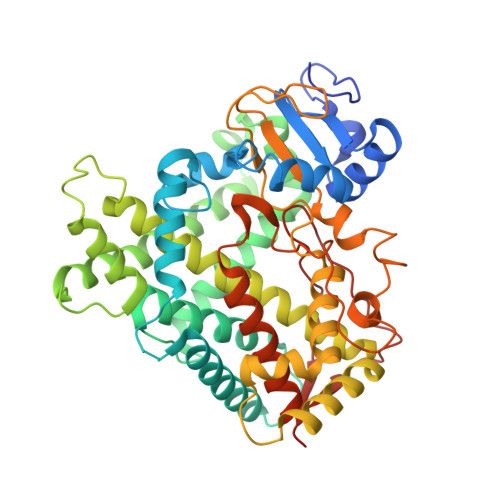Structure of Cytochrome P450 2C9*2 in Complex with Losartan: Insights into the Effect of Genetic Polymorphism.
Parikh, S.J., Evans, C.M., Obi, J.O., Zhang, Q., Maekawa, K., Glass, K.C., Shah, M.B.(2020) Mol Pharmacol 98: 529-539
- PubMed: 32938720
- DOI: https://doi.org/10.1124/molpharm.120.000042
- Primary Citation of Related Structures:
6VLT - PubMed Abstract:
The human CYP2C9 plays a crucial role in the metabolic clearance of a wide range of clinical therapeutics. The *2 allele is a prevalent genetic variation in CYP2C9 that is found in various populations. A marked reduction of catalytic activity toward many important drug substrates has been demonstrated by CYP2C9*2, which represents an amino acid variation at position 144 from arginine to cysteine. The crystal structure of CYP2C9*2 in complex with an antihypertensive drug losartan was solved using X-ray crystallography at 3.1-Å resolution. The Arg144Cys variation in the *2 complex disrupts the hydrogen-bonding interactions that were observed between the side chain of arginine and neighboring residues in the losartan complex of CYP2C9 and the wild-type (WT) ligand-free structure. The conformation of several secondary structural elements is affected, thereby altering the binding and orientation of drug and important amino acid side chains in the distal active site cavity. The new structure revealed distinct interactions of losartan in the compact active site of CYP2C9*2 and differed in occupancy at the other binding sites previously identified in the WT-losartan complex. Furthermore, the binding studies in solution using losartan illustrated lower activity of the CYP2C9*2 compared with the WT. Together, the findings yield valuable insights into the decreased hydroxylation activity of losartan in patients carrying CYP2C9*2 allele and provide a useful framework to investigate the effect of a single-nucleotide polymorphism that leads to altered metabolism of diverse drug substrates. SIGNIFICANCE STATEMENT: The *2 allele of the human drug-metabolizing enzyme CYP2C9 is found in different populations and results in significantly reduced activity toward various drug substrates. How the CYP2C9*2 variant induces altered drug metabolism is poorly understood given that the Arg144Cys variation is located far away from the active site. This work yield insight into the effect of distal variation using multitude of techniques that include X-ray crystallography, isothermal titration calorimetry, enzymatic characterization, and computational studies.
Organizational Affiliation:
Department of Pharmaceutical Sciences, Albany College of Pharmacy and Health Sciences, Albany, New York (S.J.P., C.M.E., J.O.O., K.C.G., M.B.S.); Department of Integrative Structural and Computational Biology, The Scripps Research Institute, La Jolla, California (Q.Z.); and Department of Analytical Chemistry, Faculty of Pharmaceutical Sciences, Doshisha Women's College of Liberal Arts, Kodo, Kyotanabe, Kyoto, Japan (K.M.).


















